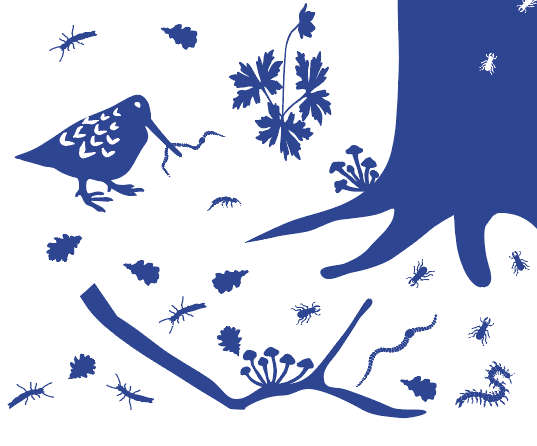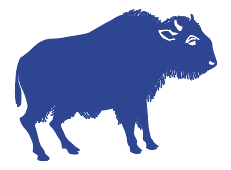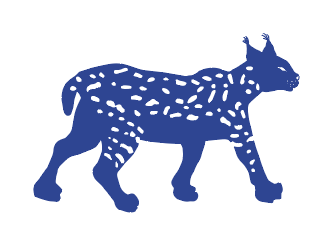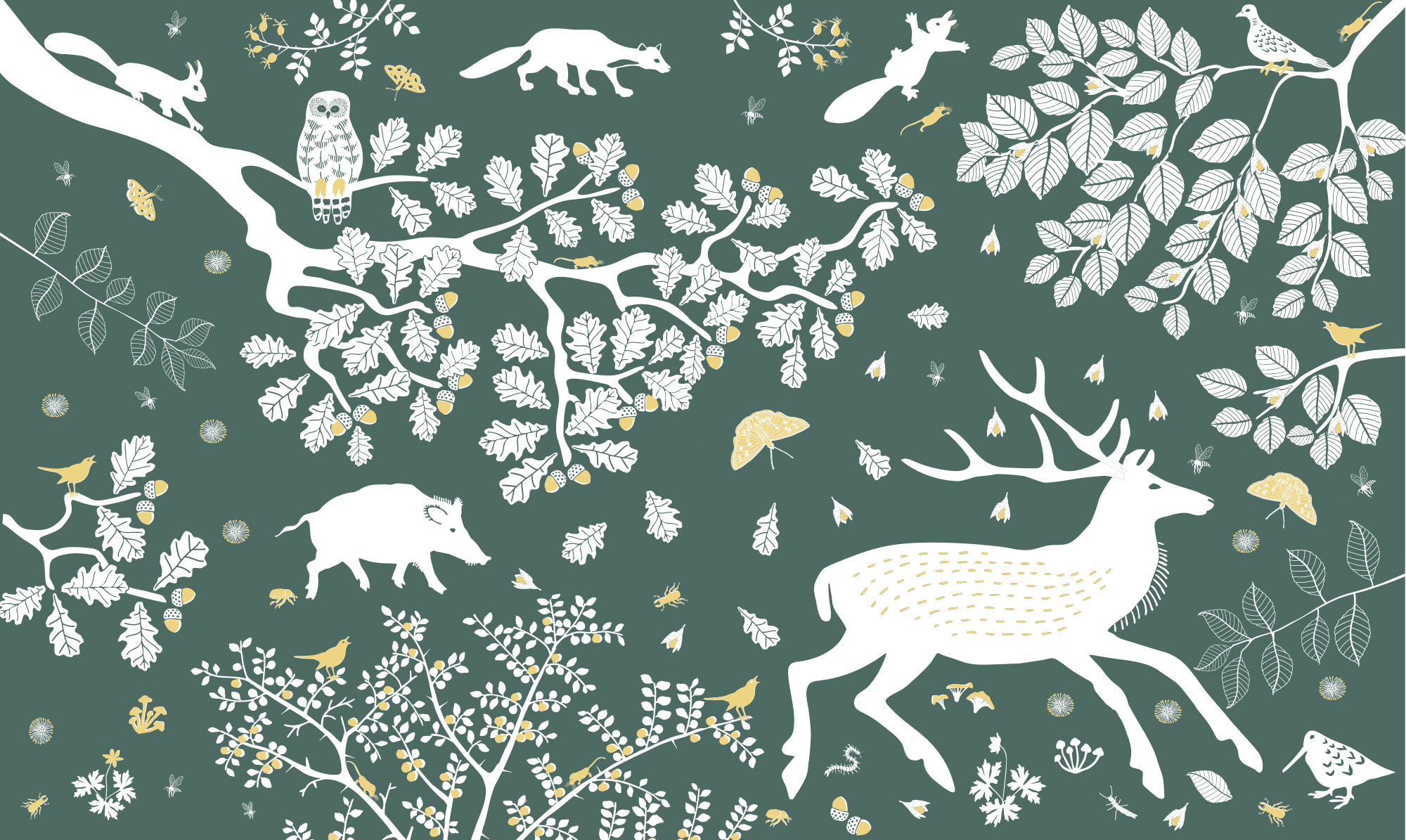This piece is about what I have learned about the British environment and how it informs the design of my Rewilding Britain Environment Print.
- The Great Un-wild
- Un-wilding
- Re-wilding
You can learn more by following the links and by downloading the reading list I have put up in the Free Resources part of this website.
3. Re-wilding
As I said in 1. The Great Un-wild, my first experience of Britain, was grave disappointment. Once the excitement of seeing real castles and going to the theatre in London had worn off, I began to feel uncomfortable about the natural environment. I have set about learning why I felt this way, 2. Un-wilding.
3. Re-wilding, is about the protection, restoration and re-wilding that is happening in Britain.
Good Science and communication
Our eyes are beginning to open. Scientists, writers, film makers and more are writing and making documentaries about threatened species, species extinctions, land degradation and climate change so that ordinary people can understand what has happened. More people are becoming aware.
I can now distinguish between a wood that is being managed to support wildlife and one that is not. I tell the difference between a field full of interesting grasses and flowers and one where biodiversity has been lost. I can see the drains and ditches in moorland, dug to extend sheep farming. My eye is trained to spot burning of heather by the grouse shooting fraternit. I now know that this damages the peat bogs on which it grows. I know that blanket peat bogs are invaluable as carbon sinks and for water retention. I understand better why. It is not just because of heavier rainfall and not enough sandbags on the night of each flood. It is because of practices that have harmed the water retention capability in the surrounding upland and moorland.
All these new lenses are thanks to the amazing books I have read, documentaries and YouTube videos I have watched, and my own lived experience in the North Pennines. And, having grown up on a farm, I also understand the tension between achieving yields and changing practices to protect the environment.
Changing Forest and Woodland Management

You might have noticed that in parks, like Richmond Park in London, or any other woodland park, dead trees and branches are being left on the ground. This is not because of staff cut backs with austerity. It is because there is growing recognition of their value in supporting soil organisms, beetles and other bugs and the wood wide web – the micorrhizal fungal network that forms mutually beneficial relationships between trees and with the soil.
Understanding of Peat Bogs as Carbon Sinks

A carbon sink is an area of vegetation, like a forest, that absorbs the carbon dioxide that we produce when we burn fossil fuels. Scientists have shown that Britain’s peat bogs are one of our most efficient carbon sinks and they are advocating for their restoration and protection. Scientists also say that because peat bogs can hold a lot of water, restoring them can slow down rapid water runoff and flooding.
In 2021 the government passed legislation to stop the burning of heather on deep peat bogs (about 40% of Britains peat bogs ) for grouse shooting. Some feel that this is not enough, but it is a start. And more people are becoming aware of the damage being done to peat lands by burning heather, ditch digging and drainage and by sheep overgrazing.
Though overdue, the UK government has passed a bill to ban the sale of compost with peat in it to gardeners by 2024.
Meadow Restoration

Meadow restoration projects as well as support for ordinary people to grow their own garden meadows and sow patches of wild flowers are increasing. Some councils are sowing wild flower seed on verges, which not only helps bees and butterflies, it also reduces the cost of verge maintenance.
The Re-introduction of some Keystone Species
A keystone species is one that has a large effect on rebalancing the environment. They restore and revitalize ecosystems. The re-introduction of wolves into Yellowstone Park in America, for example, had a positive cascading effect on the parks’ entire ecosystem.
Keystone engineers

The re-introduction of beavers in a few places in Britain is helping to control flooding and restore biodiversity. Beavers coppice trees to build dams that re-establish wetlands and create the right conditions for many other species like reeds and rushes, waterfowl, dragonflies, birds, otters and fish. Their dams and the wetlands they create, then slow down and filter flood water, making it cleaner for users downstream.

Three bison females and one male will be introduced to the dense ancient West Blean wood in Kent in 2022 as an experiment in woodland management. The bison will clear trees naturally by chewing their bark. This will create a supply of dead wood, benefitting insects and micorrhizal fungi. The work of these animals will also let in light. Because bison roll around on cleared ground, they break the soil for the reception of seeds. Deciduous trees, scrubland (e.g. blackthorn, hawthorn, dog rose) and open glades of wild flowers will re-establish themselves in what has become a dark conifer-dominated forest. With the restoration of a variety of trees and scrub, and with wild flowers growing again, insects, birds and small animals will return to the forest.
Keystone predators

Some keystone species are predators, not engineers. For a long time now, Britain has not had any apex predators like wolves, bears and lynx to control the deer population. As beautiful as they are, deer are multiplying too fast. They have a choice of delicious crops to nibble and in woods they eat saplings and new growth from coppiced trees, so that mature mother trees are growing old without building an understory to take over when they die.
Scientific conversations with stakeholders, like farmers and foresters, about the re introduction of wolves or lynx to control the deer population are increasing. It is quite possible that lynx will be re-introduced under controlled conditions in the not too distant future.
Letting Go and Reinventing the Land
Some farmers have let go. They have stopped ploughing, stopped applying chemicals, reintroduced wild animals, and turned some or all of their land into woodland meadows or nature reserves. An example of this is on Knepp farm in Sussex. By creating facilities for visitors and selling wild game meat, they are able to make a better living than when they farmed using expensive machinery and chemical products.
Note
I have shared with you the things that I have been learning. You will be able to see that my design of Wilding has been informed by these things. I am committed to sharing what I learn. The inverse of that is that I want to learn what I don’t know. So if you want to share your own knowledge or correct something, please feel free to comment or contact me.
Return to Rewilding Britain Environment Print.
